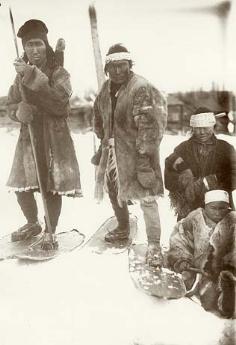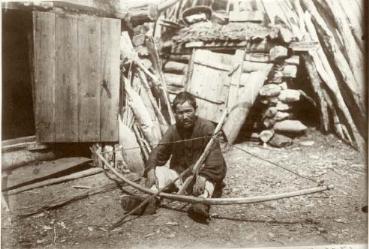This is a handout photo of Cape York meteorite specimens outside the Geological Museum in Copenhagen. [Photograph by: Canwest News Service, Photo Handout]
Posted on 02/10/2010 4:03:00 PM PST by SunkenCiv
One of Canada's top archeologists argues in a new book that the prehistoric ancestors of this country's 55,000 Inuit probably migrated rapidly from Alaska clear across the Canadian North in just a few years -- not gradually over centuries as traditionally assumed -- after they learned about a rich supply of iron from a massive meteorite strike on Greenland's west coast.
The startling theory, tentatively floated two decades ago by Canadian Museum of Civilization curator emeritus Robert McGhee, has been bolstered by recent research indicating a later and faster migration of the ancient Thule Inuit across North America's polar frontier than previously believed... around 1250 AD...
new radiocarbon data and other reassessments of Eastern Arctic archeological sites suggest the Alaska-based Thule undertook an epic voyage by skin boat and dogsled -- almost directly from Alaska to Greenland, and within a few summer travelling seasons -- about 750 years ago.
...Thule Inuit archeological sites near the Cape York deposits are older than others in Canada closer to Alaska -- further suggesting an initial dash to the northeast Arctic followed by a more gradual dispersal of population groups throughout present-day Nunavut, Northwest Territories and Yukon.
McGhee believes the Thule Inuit had learned about the valuable metal at the Cape York meteorite field from contact with Canada's aboriginal Dorset people, who were already using iron and trading it with Norse sailors from southern Greenland and Iceland.
"It would seem plausible to suggest that metal -- meteoric iron from the Cape York meteorites and metal goods traded from the Norse -- may have been the magnet that drew ancestral Inuit eastward from Alaska," McGhee contends.
(Excerpt) Read more at vancouversun.com ...
This is a handout photo of Cape York meteorite specimens outside the Geological Museum in Copenhagen. [Photograph by: Canwest News Service, Photo Handout]
Frozen Hair Yields First Ancient Human Genome
Live Science | Feb 10, 2010 | Andrea Thompson
Posted on 02/10/2010 12:57:13 PM PST by decimon
http://www.freerepublic.com/focus/chat/2448599/posts
The Northern World, AD 900-1400:
Anthropology of Pacific North America
edited by Robert McGhee,
Herbert Maschner,
and Owen Mason
|
|
|||
Gods |
To all -- please ping me to other topics which are appropriate for the GGG list. |
||
|
· Discover · Nat Geographic · Texas AM Anthro News · Yahoo Anthro & Archaeo · Google · · The Archaeology Channel · Excerpt, or Link only? · cgk's list of ping lists · |
|||
hmmm...
Tying together these peoples as in an icy Mediterranean. That’s an amazing thesis. But why not?
Rust never sleeps.
Weird. I thought only greedy Europeans did this sort of thing...
That's why the wolves can't eat them all.
Now, consider, reindeer herders can usually always catch and kill a reindeer. Not that it's all that easy, but some of these guys can just walk up to a herd eating peacefully, grab a reindeer, kill it and drag off the carcase without disturbing the others. Or, they send in a "pet reindeer" who brings back a friend who is then slaughtered.
Sometimes they have to chase them down from skis.
Obvious reindeer herders can travel immense distances quite rapidly.
So, what about Eskimos? Well, given their linguistic and genetic relationship to the Yakuts/Sakha people back in NE Siberia, I'd suspect they followed the same lifestyle some time in the distant past ~ and that would have been as reindeer herders and hunters.
These people also had domesticated dogs to assist them.
The question is really how fast could a bunch of Inuit Eskimos make it from roughly Bethel Alaska to just across from Baffin Island at York Greenland.
Taking 14 days to go 1000 miles, it seems to me a bunch of Eskimos could probably get there in under 2 months, and probably faster (using the Iditorod as a rough guide, but noting the Eskimos were probably much tougher than today's race entrants).
The Sa'ami and Norse were using skis in the 1200s (with the Sa'ami using them for thousands of years by that time). It's conceivable that the Alaskan Eskimos traveling to Greenland to get iron ALSO knew about skis.
With skis it's likely the Eskimo made it from Alaska to Greenland in just a few weeks ~ not several seasons.
"Not to worry, mates; we have all summer, ample seals to hunt and there are no brown bears on the ice."
Could be ~ and once the Arctic froze over, all the “white” brown bears (Polar Bears) would be safely out in the Arctic Ocean looking for seal meat.



With the occasional passing Siberian as an appetizer.
My pleasure. :’)
Mentioned in this article is the “Dorset People”, who were the people archeologists say were spread across Eastern Canada and northern Greenland before the ancestors (the Thule) of the present Innuit peoples.
Archeologists say that what they find about the Dorset people is (a)they were totally adapted to the frozen arctic life in Eastern Canada (from about 500 B.C. to about 800 A.D.) and had built their lifestyle on the type of hunting those conditions provided and (b)their presence in Canada seems to have ended in a very short period of time, at a time, 800-1000 A.D., when local conditions had become much, much warmer. Archeologists speculate that the changes wrought by the warmer conditions and an inability of the Dorset people to adapt to them, may have led to their decline.
But, my question is: What kind of fuel were the Norse using in their SUV’s at the time, to make the “Greenhouse” affect so great from “Greenland” to Eastern Canada - which is when the Norse started arriving there??? /sarc
rich supply of iron from a massive meteorite strike on Greenland's west coast
 |
||
| · join · view topics · view or post blog · bookmark · post new topic · subscribe · | ||
The book’s author has an earlier title listed on Amazon, it’s about the Dorsets, but I don’t remember if it’s still available. Seems like it would have been a big seller. ;’)
What's the big mystery? Didn't the Dorsets use the iron to pay the Vikings for passage to Britain, then migrate to a particular area of England, now called Dorsetshire, and become sheep herders? There's even a breed named for them.

The World Largest Piece of Cape York Agpalilik Meteorite at JOGS Gem Show
Meteorites are meteors that reach the surface of the earth without having disintegrated. The Cape York Meteorite, which comes from the center of a small planet that was broken apart, is a type known as an iron meteorite; it is composed of metallic iron and nickel, similar to the metallic core at the center of the earth.
The Cape York Meteorite Shower, named for the site in Greenland at which it collided with the earth some 10 thousand years ago - is 4 1/2 billion years old and was exposed approx 93 million years to cosmic rays, before separating from its planetary mother body. It is the largest meteorite shower known and the classic of all meteorites.
Cape York or Kap York is situated at the northwest coast of Greenland about 65 miles south of Uummannaq at the Buffin Bay. Besides of the Agpalilik, 11 large parts where found since the famous Arctic explorer Robert Peary discovered the first piece in 1894.
It took Peary three years to manage to load the pieces onto ships and required the building of Greenland's only railway. These pieces where sold to the American Museum of Natural History in New York, where they still stand.
Five previous expeditions between 1818, when the Greenlandic meteorite field came to be known, and 1883 failed to find parts of the Cape York Meteorite shower. In summer 1963, the fourth major piece of the Cape York meteorite, the Agpalilik, was discovered by Dr. Vagn Buchwald from Copenhagen.
Agpalilik Peninsula where the Agpalilik was found, is located 75 miles southeast of Thule and 10 miles north of the Savigsivik settlement;
The Agpalilik meteorite, also known as the Man, weighs around 20 tons and currently resides in the Geological Museum of the University of Copenhagen. Other smaller pieces have also been found, such as the 3 ton Savik I meteorite in 1911, the 48 kg Thule meteorite in 1955, the 7.8 kg Savik II in 1961, and the 250 kg Tunorput fragment in 1984.
The Agpalilik represents a medium Octahedrite III AB iron meteorite and consist of 91% Iron, 7,58% Nickel, 19,2 ppm (10-6) Gallium, 36,0 ppm Germanium and 5,0 ppm Iridium.
The displayed piece of Agpalilik at the J.O.G.S. Show is a solid core piece with wonderful Troilite inclusions with a weight of 100kg.
http://www.jogsshow.com/largest_meteorite.htm
Disclaimer: Opinions posted on Free Republic are those of the individual posters and do not necessarily represent the opinion of Free Republic or its management. All materials posted herein are protected by copyright law and the exemption for fair use of copyrighted works.